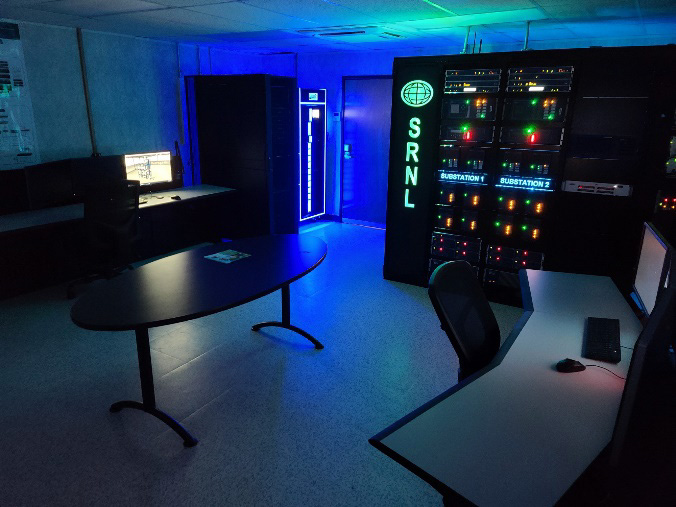SRNL Support to DOE Office of Intelligence and Counterintelligence in FY 23
SRNL Support to DOE Office of Intelligence and Counterintelligence in FY 23
SRNL provides technical expertise to the U.S. Intelligence and Counterintelligence communities, which makes it a valuable resource for nonproliferation efforts.
Examples of how SRNL supports DOE Office of Intelligence and Counterintelligence:
- Nuclear reactor operations and modeling
- Plutonium and tritium processing
- Spent nuclear fuel reprocessing
- Environmental modeling
- Materials science
- Nuclear material security
- Chemical and biological threats
- Grid security

Accomplishments Overview:
In FY23, SRNL delivered several products to senior DOE-IN policy makers. Furthermore, SRNL provided three courses on nuclear operations and nuclear material production training to the intelligence community, as well as participating in multiple partnerships with other members of the intelligence community.
SRNL’s Counterintelligence (CI) program enables DOE and NNSA to identify and mitigate foreign threats to the Savannah River Site (SRS)’s facilities, personnel, information, and technology, which is a critical mission for both organizations. The program is focused on being proactive, intelligence-driven, and integrated across the SRS.
Key Accomplishments and Associated Impacts
Analytic Products
SRNL staff authored or co-authored approximately 25 analytic products for the DOE-IN Foreign Nuclear Program in FY 2023. Of these 25 products, two were selected as supplements in the President’s Daily Brief, and 9 others were briefed to senior policy makers and senior Department of Defense (DoD) customers. Of these products, two were dual-seals written in collaboration with other Intelligence Community (IC) partners, while a third was a partner product with SRNL technical contributions.
Mitigating Risks of Research Security
A joint workshop with the DOE Counterintelligence Savannah River Field Office brought together officials from 11 research universities/colleges, the DOE office of the General Counsel, and the Federal Bureau of Investigation (FBI) to discuss how each group can improve security best practices, identify foreign threats, and tackle challenges in the U.S. academic research world. The workshop also featured a discussion of the National Security Presidential Memorandum-33 (NSPM-33), a directive to strengthen and standardize disclosure requirements for federally funded awards and establish research security programs at research institutions receiving federal funds.
Support to Intelligence Community Partners
The Lab participated in five interagency working groups and hosted a DOE-IN working group, to advance analysis in the areas of nuclear fuel cycles and emerging technologies. Moreover, SRNL analysts provided substantive remote sensing support for thermal and hyperspectral imaging domains to interagency partners. SRNL capabilities range from fundamental science regarding these technologies to advanced modeling and simulation. SRNL also taught three courses on the nuclear fuel cycle to members of the IC. This work is designed to enhance our Nation’s ability to answer both tactical and strategic intelligence questions.
SRS Foreign Intelligence Threat
More than 2,000 SRS employees were informed of the DOE Counterintelligence Savannah River Field Office (CI-SRFO)’s strategic goals and objectives, including a realistic picture of the foreign intelligence threats to SRS in FY23. CI-SRFO also provides briefings on foreign travel, hosting foreign visitors, and other timely national security issues with staff members. CI-SRFO released a site-wide monthly newsletter that promotes CI awareness for all SRS personnel.

Cybersecurity, Precision Timing, and Grid Testing Capabilities
Core Capabilities
SRNL – Critical Infrastructure, ICS, and Cybersecurity Lab (S-CIIC)
- Controller Hardware-in-the-loop and Virtualization
- Level 0 Modeling
- Grid (RTDS, Typhoon)
- Level 1 & 2 Physical
- SEL Relays, RTAC
- GPS Clocks
- PLC’s (Modicon, Siemens)
- Level 3 to 5 Virtual
- VMWare Cloud Foundation
- Precision Timing Clocks
- SEL 2488, Spectracom, Trimble, and Oscilioquartz
- PTP synchronization to ORNL Grandmaster
- Broadsim GNSS Simulators

SRNL’s Critical Infrastructure, ICS, and Cybersecurity Lab (S-CIIC) located on site at SRS.
Transmission Testing
- 93 miles of 115kV Transmission Lines
- 3 tie points to Dominion Energy
- 14 Transmission Substations
- 18 Step-Down Transformers
- Successful installation of Fiber Optic Voltage and Current sensor on Transmission
- 17 miles of disconnected Transmission Line
Research Focus Areas
- SCADA vulnerability assessment
- Electrical grid resiliency
- Secure timing and latency
- Next generation sensor deployment
- Harmonic and power quality hardening
Proposed Capabilities
- Integrating SCIIC into the DOE-IN Network through ESNET with grid simulation and SCADA connections
- Testing of different alternate timing sources on protection devices driven by RTDS or Typhoon
Provided Benefit
- Creates a dedicated lab for integrating backup timing sources into the electric power grid
- Simulations and scenarios performed throughout the partners will drive the behavior in the lab
- Adds in a new threat environment through electronic warfare

Electric Phenomenon Clusters installed on SRNL transmission network.
Expansion Areas and Future Capability
- Deployment of next generation equipment on Defense Infrastructure for advanced hardening of nations stockpile
- Classified Grid Modeling
- Medium Voltage Testing
- EMP Modeling and Testing